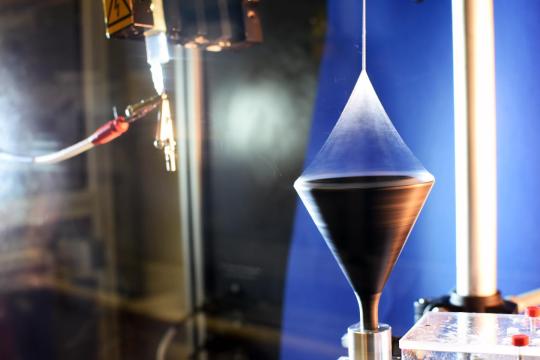#materialscience

Electrospinning of a multifibrillar polyacrylonitrile fibre. Image credit: University of Bayreuth/Rennecke.
By Anthony Caggiano
University of Beyreuth, Germany, researchers have developed lightweight and strong polymer fibres through electrospinning.
Polyacrylonitrile is the chemical base of the fibre, of which a single one with a diameter of about 40,000nm consists of up to 4,000 ultra-thin fibrils.
One individual fibre is as thin as a human hair and can lift a weight of 30g without tearing – working out to about 150,000 times the weight of a fruit fly.
These fibrils are linked by small amounts of an additive, poly(ethylene glycol) bisazide (PEG-BA). Three-dimensional X-ray images show that the fibrils within the fibre are almost always arranged in the same longitudinal direction.
Bayreuth Polymer Scientist, Seema Agarwal, explained the process.
‘We prepared these multifibrillar polyacrylonitrile fibres in a laboratory for electrospinning at the University of Bayreuth and extensively tested them for their properties and behaviour. Their unique strength in combination with high toughness never ceased to fascinate us,’ Agarwal said.
Beyreuth Macromolecular Chemistry II research group leader, Andreas Greiner, said, ‘experiments on the high tensile strength of these fibres have furthermore revealed their high toughness. This means that each individual fibre can absorb a lot of energy.’
The overall properties were comparable to those of spider silk.
The researchers claim the polymer fibres are suited to technical components that are exposed to high loads. They enable innovative applications in a wide variety of fields, for example in textiles, aerospace, automotive engineering, or medical technology.
The fibres are also recyclable.
Other partners in the project were researchers at the Forschungszentrum Jülich, the Martin Luther University Halle-Wittenberg, the Fraunhofer-Institute for Microstructure of Materials and Systems (IMWS), the Rheinisch-Westfälische Technische Hochschule Aachen University, the Jiangxi Normal University, Nanchang, and ETH Zürich.
The results were published in Science. Find the paper here:

A sample all-inorganic perovskite solar cell is a step towards toward commercial use, according to scientists at Rice University. Their discovery of a way to quench defects in cesium-lead-iodide solar cells allowed them to preserve the material’s band gap. Image credit: Jeff Fitlow/Rice University
By Anthony Caggiano
Rice University scientists have replaced some of the lead in perovskite solar cells with indium, which could help improve their performance.
Rice materials scientist Jun Lou and his colleagues at the Brown School of Engineering have been able to better manage defects in cesium-lead-iodide solar cells that affect the compound’s band gap, a critical property in solar cell efficiency.
The cells can also be made in open air and last for months rather than days with a solar conversion efficiency slightly above 12%.
Traditionally, materials used in perovskites - crystals with cube-like lattices and are efficient light harvesters – tend to be stressed by light, humidity and heat.
Rice postdoctoral researcher and lead author Jia Liang and his team built and tested perovskite solar cells of inorganic cesium, lead and iodide, the very cells that tend to fail quickly due to defects. But by adding bromine and indium, the researchers were able to quash defects in the material, raising the efficiency above 12% and the voltage to 1.20 volts.
As a bonus, the material proved to be exceptionally stable. The cells were prepared in ambient conditions, standing up to Houston’s high humidity, and encapsulated cells remained stable in air for more than two months, far better than the few days that plain cesium-lead-iodide cells lasted.
‘The highest efficiency for this material may be about 20%, and if we can get there, this can be a commercial product,’ Liang said. ‘It has advantages over silicon-based solar cells because synthesis is very cheap, it’s solution-based and easy to scale up. Basically, you just spread it on a substrate, let it dry out, and you have your solar cell.’
By Anthony Caggiano

WoodBeQuiet panels installed on the ceiling to reduce noise in an office in San Diego, USA. All images: Acoufelt
Recycled plastic has been used to develop a series of noise-absorbing panels designed to look like timber.
TheWoodBeQuiet range of planks by Acoufelt are made from polyester fibres with more than 60% recycled content.
PET-based recycled plastic beverage bottles that normally would go to the landfill are cleaned and then cut into flakes before being melted and extruded into fibres of natural white colour. These regenerated fibres are then carded and thermo bounded to form rigid, acoustic panels.
But the extra magic lay in how they could be sound-absorbing.


Panels used on a wall installation.
Acoufelt Marketing Manager - Global, Lucy Pittman, told Materials World the planks are made by a print technology process where the colour is targeted to the areas of the panel, while ensuring air-gaps in the porous material remain open to absorbing noise. The net result is a printing technique that is high resolution, and has no significant impact on the acoustic performance of the base material.
‘Many other high-resolution printing techniques involve laying down a hard-setting paint or ink over the top of the base surface. This can result in a filling of the air gaps in the porous surface of an acoustic material, inhibiting noise absorption,’ she said.
‘Other printing techniques allow the colour to “run” in the material, like a drop of ink on a blotting sheet. This can result in poor resolution as the fine edge of the images blur.’
The panels can be used for walls and ceilings, and applied to hard surfaces including screens, partitions and ceiling baffles.
